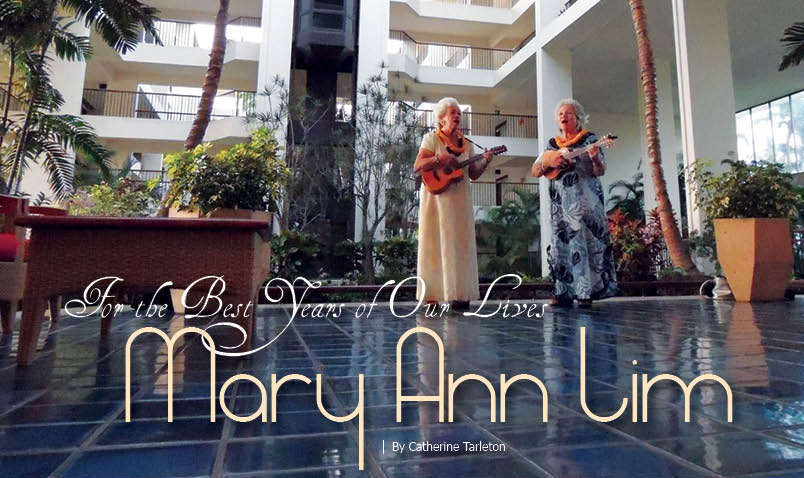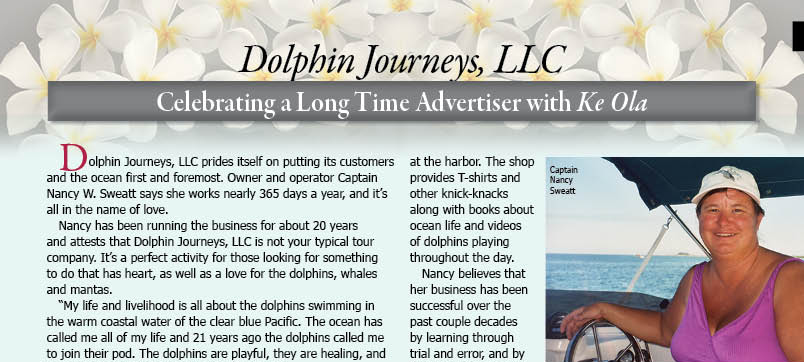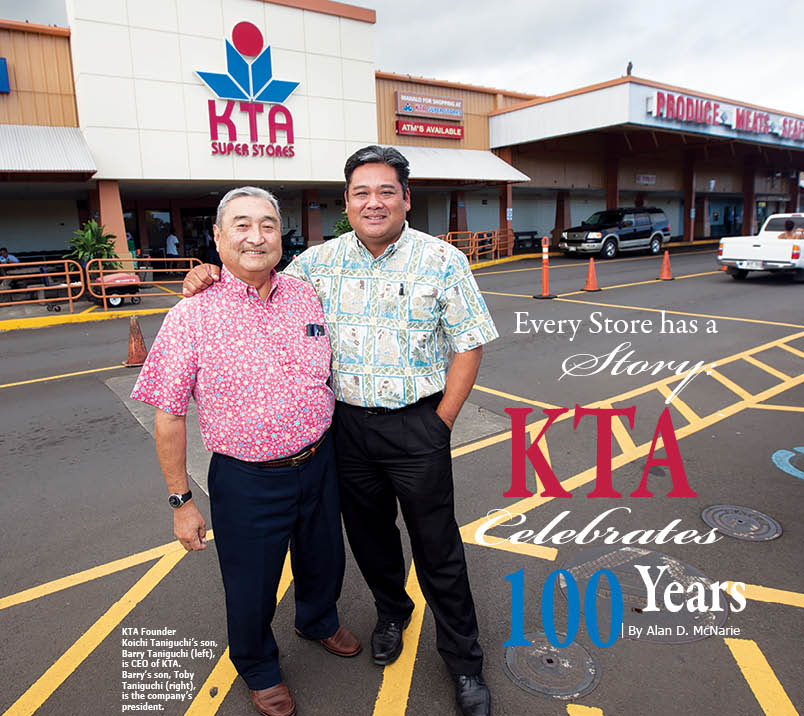
For the Best Years of Our Lives: Mary Ann Lim
By Catherine Tarleton
Aunty Mary Ann Lim piles out of her Honda CR-V and hands me her ‘ukulele as she gathers up two fragrant puakenikeni lei and a spritzer bottle. Hair perfect, white mu‘umu‘u, Tahitian pearl, lavender jade and Hawaiian bracelets jingling, she clips on shell earrings, finds her lipstick, and adds color to the flashing smile that completes her look.

Once inside, seated in the open atrium at Mauna Lani Bay Hotel, with late afternoon sun streaming across the ocean-blue tile, she spritzes the lei and places it around her neck, folds the other back into a kitchen towel. “It’s sad if you have flowers and don’t use them,” she says.
She picked the flowers this morning, after weeding the garden a while, tossing in some laundry and making breakfast for her granddaughter. She’ll give the second lei to Halani Berard when she arrives, completing the musical duo they laughingly call the Golden Girls, who serenade guests three nights a week.
“My dad taught me to play,” Mary Ann says. “I think I still play like him. Simple, simple. Sonny scolds me. I just like the way it was.” Her musical laugh says she is teasing about her son Sonny Lim, award-winning Hawaiian musician and slack key artist. Sonny’s sisters are Charmaine Davis, and Nā Kumu Hula Nani Lim Yap, Lorna Lim, and Leialoha Amina.
As matriarch of the legendary Lim Family, Mary Ann’s ‘ohana includes Merrie Monarch champions, winners of Nā Hōkū Hanohano Awards, songwriters, singers, dancers, kumu hula, and more. Grandson Manaola Yap is an up-and-coming fashion designer in demand. A busy family with widespread branches, the Lim’s are deeply rooted in Kohala, where mother Mary Ann’s genealogy reaches back to Hawaiian ali‘i.
Mary Ann Neulu was born in her grandparents’ home in Hawi Homestead March 23, 1936. “All my mother’s sisters went to their parents home to give birth,” she says. “They had a midwife who helped.”
Her father, William Neulu, worked for Niuli‘i Mill, eventually Kohala Sugar. “Neulu is an old name,” says Mary Ann. “You can’t find it today. Neulu was one of the ruling chiefs of Hawai‘i—from the line of ‘Umi, chief of Waipi‘o.”
Her parents and grandparents would speak Hawaiian at home. “I heard it all,” says Mary Ann. “They could speak but they couldn’t teach us. I can understand, but can’t speak it, only a very little.”
Until the Hawaiian Renaissance era, schools suppressed teaching Hawaiian language, and other elements of culture. Thankfully, interest was revived in the 1970s.
Life in Niuli‘i and other communities revolved around the sugar cane industry. Before Mary Ann was born, there were seven sugar mills in the Kohala District: Kohala, Union, Niuli‘i, Hawi, Halawa, Hō‘ea, and Star. In 1937, they were consolidated into Kohala Sugar Company, which at its peak had 600 employees and produced 45,000 tons of raw sugar on 13,000 acres. A network of waterways diverted streams to the mills; a narrow gauge railroad delivered sugar to landings around the island.
“The train passed by our home,” she says. “It was driven by our neighbor, Mr. Akana. He was the conductor. I remember the whistle blowing, the burning cane, the cane trucks. We knew the numbers of all of them, and there were flumes passing by our house. We used to catch the canes out of the water and chew them. We said ‘that’s our toothbrush.’ ”
“There was a Filipino camp, a Korean camp, Chinese, and Japanese camps. The Hawaiians had their houses nearby, and there was another Filipino camp at Makapala,” she says, referring to the plantation system of housing imported laborers, grouped by nationality. “I met all these different people. We knew their children; we knew all the family names, the elders.”
The holidays were very special occasions, especially for the children. “Every home made food for you,” Mary Ann says. “I used to go with the Filipino musicians and serenade everybody when I was nine or 10 years old.” With a close knit family and extended ‘ohana of many friends, Mary Ann says they often reminisce about those times. “When we meet each other we talk about it, and we realize the changes,” she says. “It was hard work before—and we still work hard. Our children can’t keep up with us.”
Her father taught her to play ‘ukulele at a young age, and her first kumu hula was Aunt Sarah Pule (wife of community leader and legislator Akoni Pule for whom the highway is named). “I went for two days, then came home and said I don’t want to learn,” says Mary Ann with a smile. Fortunately, Margaret Moku, another teacher in the neighborhood took her under her wing. “She used to say, ‘If you just walk in and I’m teaching, you come in too,’ ” says Mary Ann. “There were always all these kids over there, hanging out the window, on the porch. ”
“I was a dancer for many years, from when I was five or six years old. We danced for the USO,” Mary Ann says, remembering when 50,000 marines came to Waimea’s “Camp Tarawa,” to train for the battle of Iwo Jima. “We took our May Day shows to Waimea. At that time, the tutu’s went and threw money—and then the military threw so much money we had to go with a push broom to collect it all.”
Mary Ann never dreamed of being a professional entertainer. “I wanted to be an accountant, a bookkeeper, or a secretary,” she says. “I still know shorthand.” In fact, she uses shorthand at times to capture song lyrics as she hears them.
She went to school at Makapala, graduated from Kohala High School, and continued to play music and sing in church. “We all could sing,” says Mary Ann, remembering her friend, the late Clyde “Kindy” Sproat, another of Kohala’s legendary musicians and storytellers, who lived nearby. “Later, when he was in the military, he heard the Lim Family’s music on the radio and realized ‘I know those people.’ ”
About that time, Elmer Lim came back to town. He and his family had moved to Honolulu when the mills were closing, and he returned with a roofing company, to re-roof the elementary school. “He and a friend opened a pool hall,” says Mary Ann, and I used to hang around the store. Candy was only five cents.”
Elmer was a talented ‘ukulele and guitar player, and singer. On O‘ahu, he had played with name entertainers. “He was with Eddie Kamae, Joe Marshall, Linda Delacruz, Ililani Miller, the Kalima brothers,” says Mary Ann. “The brothers were so big they took them around to gigs in a flatbed truck with the piano.”
“He was a Dragon and I am a Rat,” she says, referring to their Chinese astrological signs. “We were a perfect match.” She and Elmer married in 1954. He went to work at Parker Ranch as a Caterpillar driver then trucking foreman, and the family moved up to the bucolic ranching community of Pu‘uhue (near Kahua Ranch). They would sing and play together, and when the keiki came, they joined in the growing Lim Family music tradition.
At one point, Mary Ann was working as a custodian in the plantation office in town, and noticed a photo display showing families on house lots that the company had given free and clear. She asked a girlfriend who worked there, and learned there was one more available. “I said ‘my father didn’t know about that,’ and I ran home and got Dad, and got my husband. And I got the lot,” she says. “That first night we stayed there, nobody slept. There was no mooing cows, and those familiar sounds.”
In 1965, Mary Ann started working for the Mauna Kea Beach Hotel, the island’s first luxury resort, before it opened. “I was a cafeteria food server,” she says. “I had to climb through the sand piles and ladders and everything to serve hot food to the workers, I loved it. I love to cook.” Her 30-year career there was not limited to the kitchen, however.
“Our Food and Beverage manager had musicians here and there,” says Mary Ann, who knew that Aunty Margaret once invited him to a lū‘au at Keokea Beach Park, where he saw the Lim’s playing music. “So, one time he got stuck, and he called me to play for cocktail hour,” says Mary Ann. “Then that worked up to several nights a week, with traveling time included.”
The Lim Family, in various forms, entertained at the hotel’s famed lū‘au for the next five decades, continuing today with daughter Nani and husband Ed Yap’s company, Traditions Hawai‘i.
In 1988, Mary Annʻs husband passed away suddenly. They had been married for 34 years. Mary Ann remembered a sermon from some time in the past. “They asked the question, ‘Are you able to take care of yourself if you lose your spouse?’ ” she says. “And I said, ‘Yes, I think I can. I will.’ I was never afraid.”
“My husband died during Merrie Monarch time,” she says. “He had so many friends. My garage was so full of vegetables, the Love’s driver brought all these buns, and breads and rolls, the people who fished brought fish.” In the days ahead, she went through his possessions. “I made different bags for my sons, with his clothes and things. The only thing they couldn’t use were his shoes. Their feet were too big.”
Her faith was tested again in 1997 when son Kimo was killed in a helicopter accident at age 29. “Kimo was a powerful male dancer. He had so much energy,” she says, touching the Hawaiian bracelet on her wrist. The inscription inside reads, “For the best years of our lives, Aloha, Dad, and Children.”
Today, she is a super busy Tūtū of 13 grandchildren, three great-grandchildren, and nearly countless nieces, nephews, and hānai relatives. Always on the go, she plays music in the Mauna Lani’s atrium three nights a week with her friend Halani Berard, and appears at numerous fundraisers, concerts, music festivals, and special events—with various combinations of the Lim Family—across Hawai‘i and beyond.
“I love to travel; I love to go to Japan. I’ve been over 100 times. The people are nice, and the food is extra nice,” she says.
Mary Ann also belongs to the local chapter of the Organization of American Chinese Women of the Island, and is actively helping with their history project. She works with Lorna’s hālau, and is learning to speak the Hawaiian language she loves.
If that’s not enough, she wants to write a book for her family, and is an enthusiastic supporter of the Zurvita nutritional products that she uses and sells to her friends.
“I look back at what a rich life I’ve had,” says Mary Ann, as Halani arrives with her beautiful ‘ukulele, handcrafted by Mary Ann’s late husband. Mary Ann gives her the lei and they take a moment to tune up. Hotel guests fill the chairs and are greeted with a warm “Aloha.” As they sing, soaring voices drift up through the atrium, lift songs to the upper floors and the clouds above, heading heavenward. ❖
E ho‘i ke aloha i ke Kulaiwi
A chant of Kohala, written by Lorna Lim, Nani Lim Yap, and Leialoha Amina.
| E ho‘i ke aloha i ke Kulāiwi | Come with love to the homeland, |
| Ka ‘āina ka makani ‘olu o Kohala | The land, the beautiful, pleasant wind of Kohala. |
| Kū i ka la‘i O Pili me Kalāhikiola | Stand in the calm place of Pili and Kalāhikiola, |
| ‘Ekolu pua wili ‘ia me ke aloha | Three flowers entwined with love, |
| (No) Nā pua, Nā Lei, Nā mamo lā eā…eā…eā | The flowers, the lei, the generations. |
To be chanted three times.
Contact writer Catherine Tarleton



